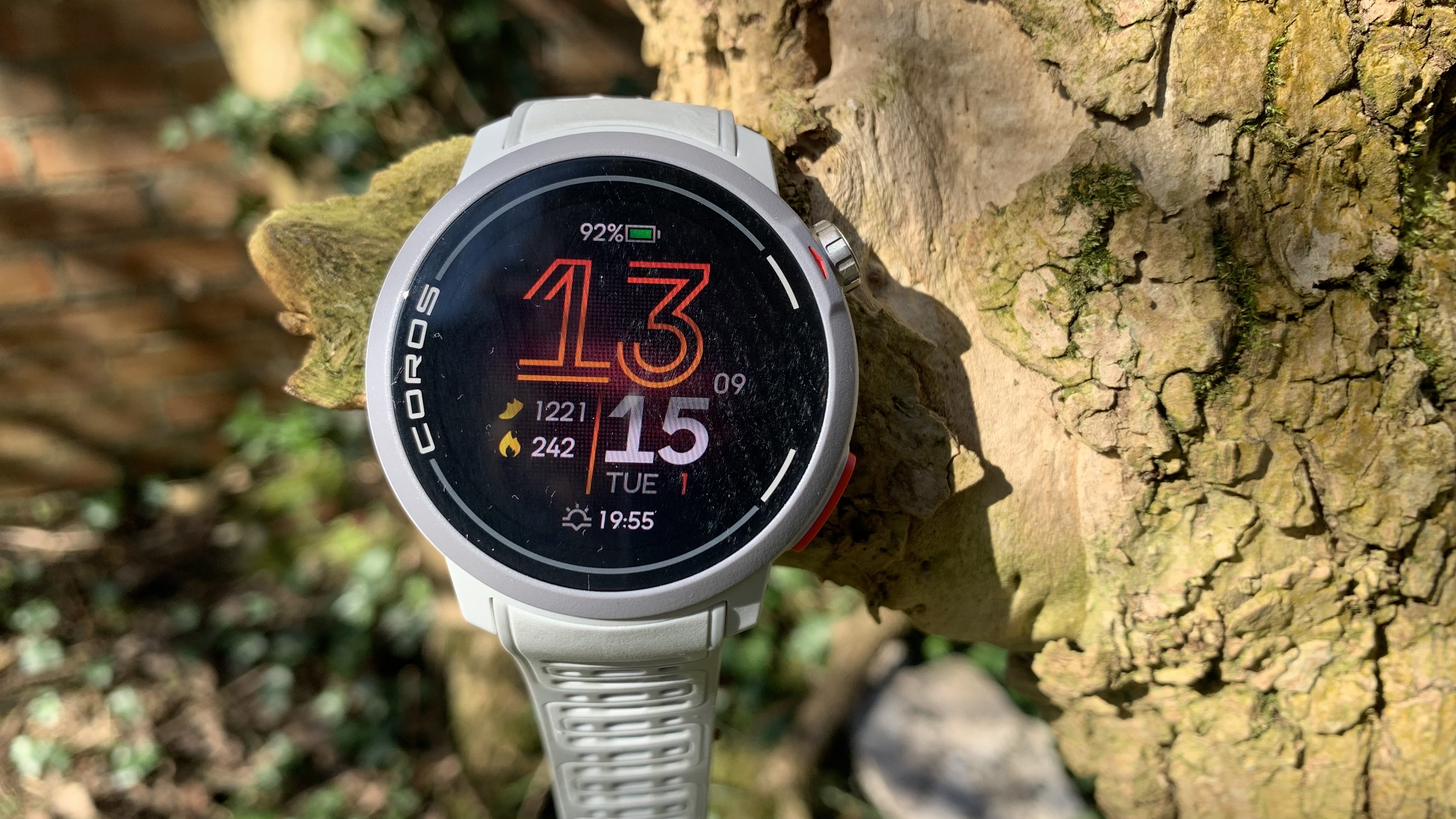
Coros Pace Pro: first impressions
The Coros Pace Pro is the California-based brand's most advanced GPS watch to date and its first foray into an AMOLED screen. After several weeks of testing this watch in the field, it looks as though Coros has produced its first real competitor for more technical watches from rival brands like Garmin and Suunto.
The first and most obvious difference between this watch and its predecessor, the Pace 3, is that it's bigger. The Pace Pro boasts a 1.3in screen, which means it's easier to see and use maps, but it also means this watch is too big for smaller wrists. Though you can choose between nylon and silicone brands, there aren't yet any options for screen size.
Fire it up and you'll see the next big upgrade, a bright 1500 nit AMOLED screen that's easy to see whether you're hiking in bright sunlight, running in the rain or adventuring at night. The screen is really responsive when you lift your wrist, and the touchscreen feature works perfectly.
In design, this watch looks a lot like the Pace 3 with just two buttons to operate it: a rotating Start/Stop button to scroll through options and select features, and a Back button that can cycle through data like sunrise and sunset times and heart rate or access system settings and additional features like alarm and stopwatch. The rotating button does stick out enough that we notice our sleeves often twiddle it to change the screen mid-run, and actually discovered that we accidentally kept pausing our workouts doing planks.
As for what's new, this watch features a visibly faster processing speed compared to the Pace 3 and a new blood oxygen monitor and optical heart rate sensor that should be improved but we had some trouble with it. After a lot of testing, we think that the main problem may be that the silicone strap doesn't work for smaller wrists, so we'd recommend you get the nylon strap for the most accurate readings.
• List price: $349 / £349
• Case sizes: 46mm
• Display: AMOLED
• Weight (with silicone strap): 1.7oz / 49g
• Battery life: 20 days in Daily Use / 38 hours in GPS mode
• Water rating: 5ATM
• Materials: Fiber reinforced polymer bezel, mineral glass lens
• Best use: Trail running, Hiking, Swimming, Cycling
The biggest and best new feature is the addition of topo maps. Whereas the Pace 3 just offers basic pointer breadcrumb navigation, the Pace Pro provides Global maps with turn-by-turn navigation of off-route alerts. In the wilderness, we found the GPS to be not quite as accurate as it is on a premium watch like the Garmin Fenix 8, but it wasn't off by more than a few feet and still gave us everything we needed for a safe journey through the backcountry.
It uses the same Coros app as the Pace 3 (and you can add multiple Coros watches and choose which one you're using) which is intuitive and easy to use and you'll have access to the same training features such as recovery suggestions, VO2 max, sleep tracking, training load and your running fitness score. Like any GPS watch these days, there are certain metrics like HRV (Heart Rate Variability) that you can't access if you don't wear it while you sleep and it is a fairly big watch to sleep with, but that's a personal decision. It's fully waterproof for pool swimming, but note that this is not a diving watch.
Like the Pace 3, it's not a true smartwatch, though you can read text messages and other notifications on it. That, however, means excellent battery life. The brand promises up to 38 hours on GPS mode and 20 days in Daily Use mode, which is a significant improvement on its predecessor. In real terms, that means we've used it daily for three weeks and only had to charge it twice (it takes less than an hour to charge).
Finally, like the Pace 3 this watch does still look a little cheap compared to the competition. That's mostly down to the plastic case, which is robust enough, but it's good to know that the screen is a mineral glass is more prone to damage than the sapphire crystal that's used by competitors like Garmin, which could be an issue if you're planning on rock climbing or other more rugged pursuits.
All in all, this is definitely the most advanced watch from Coros so far and it comes with some significant upgrades in terms of the display and maps. We'd like to see the heart rate sensor be more reliable, even if it's just down to a design that sits more flush against the skin, and we wouldn't say no to the addition of a flashlight, even if that does drain the battery. But if you've been looking for an intuitive and advanced training watch with excellent maps, this one is a lot more affordable than a lot of Garmins.
Coros Pace Pro: in the field
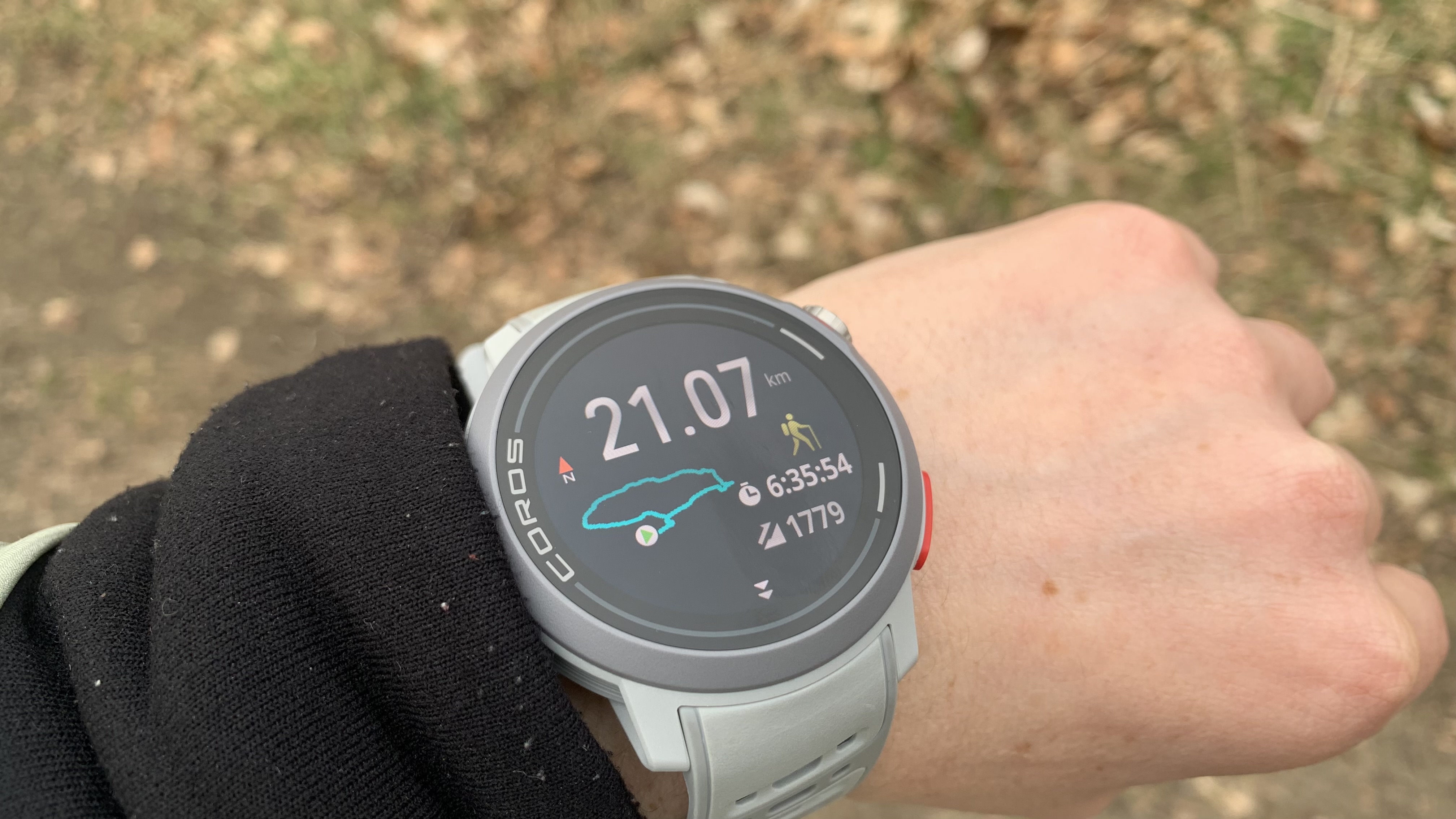
I've been wearing the Coros Pace 3 for about 18 months so I was eager to get my hands on the Pace Pro and compare the two. I've been testing the Coros Pace Pro for the past three weeks and during that time I've used it for six hill runs (two at night), three hikes including a 20k Munro round, two pool swims and eight yoga classes.
I've been wearing it on my left wrist with either the Amazfit Active 2, Garmin Fenix 8 or my Pace 3 on my right wrist to see how it compares in terms of accuracy and metrics.
Here’s how it performed:
Design
The 46mm case is an undeniably big watch on a wrist such as mine, and while I appreciate being able to see the information on the screen so well, the design has posed some problems.
First, it's just a little bulky when wearing it in cold weather where I often have two or three layers on and that not only makes it hard to access but means that my sleeve often turns the rotating button while I'm running or hiking. That means that when I'm using Maps, I quite often find myself having to twiddle back to the map screen. I also discovered during a yoga class that wearing it with the buttons on the side of the watch closest to my hand means I sometimes accidentally pause the workout while holding a plank.
It only recently occurred to me that when I set it up, I could have set the buttons to be on the other side, which would make them slightly more awkward to reach but would solve these problems.
The biggest issue I had with the design was that I tested the silicone band and it just doesn't quite work with my wrist. To be comfortable, I ended up wearing it slightly too loose which I think interfered with the sensor's accuracy, and the band itself is really fiddly to fasten. I'd recommend saving yourself the hassle and just going with the nylon strap which is is what I have on the Pace 3. It's easier to secure and to wear comfortably, thanks to hook-and-loop fastenings.
Those quirks aside, I like the simple, intuitive two-button design of the Pace Pro and only wish it didn't look quite so cheap.
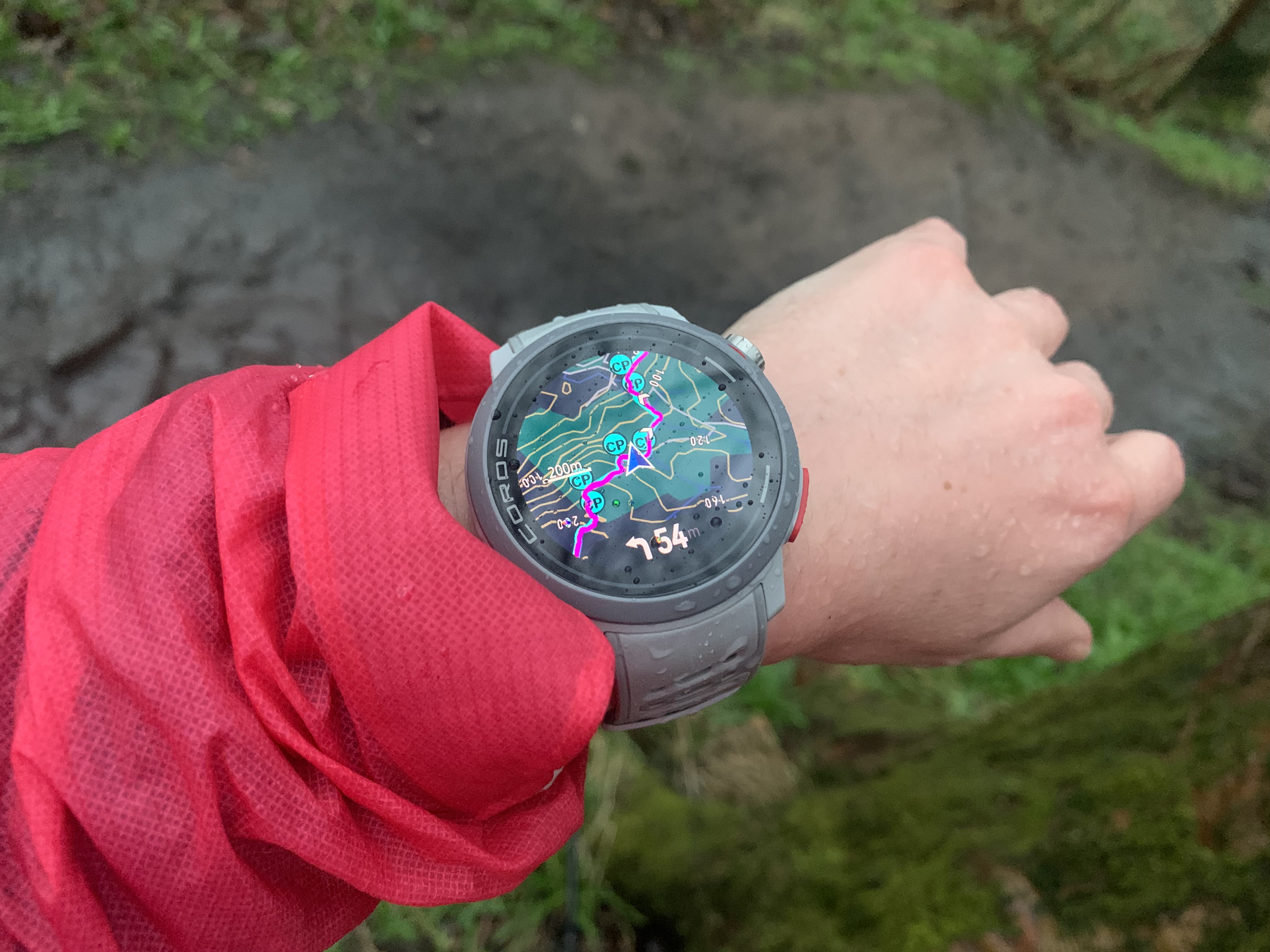
Features
This watch has tons of features, and many are already available in the Pace 3 in terms of training tools, so I'll focus on what's new. The biggest upgrade and the one I've got the most use out of is the addition of topo maps, which I've used on every hike and trail run.
To get a preloaded route, I downloaded a GPX file on my computer from AllTrails, emailed it to myself and then opened it on my phone using the Coros App. That's a bit of a hassle (though no more so than with the Fenix 8) but once it's open, it takes seconds to get it on my watch, and then when I'm ready to use it, I just head straight to Hike or Trail Run and it's sitting there waiting for me.
I've used map navigation in brilliant sunshine, torrential rain and at night and it really is crystal clear. The display is really responsive any time I lift my wrist, and you can turn it from Always On to dimmed or intermittent to save on battery life. The touchscreen feature isn't new compared to the Pace 3, but I think it's faster and more responsive, so I've found myself using it where I turned it off on the Pace 3.
The sensors mean you can get your hands on all kinds of metrics: sleep tracking, heart rate, HRV (if you wear it 24 hours a day), Pulse Oximeter (SpO2) and ECG. Meanwhile, there are plenty of great training tools for runners, like a personal pacer, race time predictor and training plans.
It's not a smartwatch, but I can see my text messages and other notifications and it buzzes to let me know if someone is phoning, but personally I don't really need a watch I can make phone calls with so I'm happy with that.
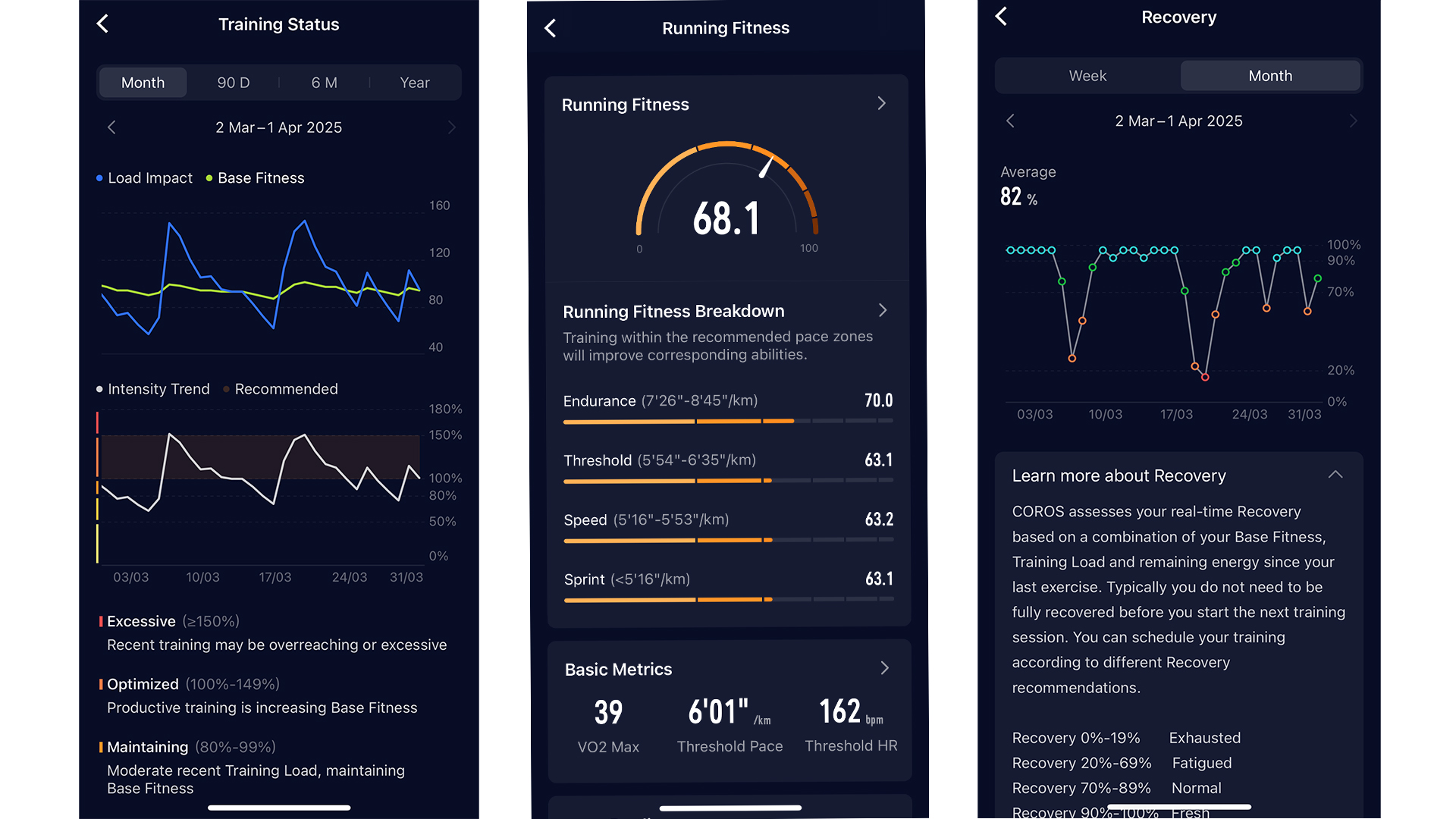
Performance
I'm primarily a hiker and trail runner, so I wanted to get this out in the field and test its GPS capabilities with maps, while the health metrics were of interest, but more of an auxiliary feature for me.
After testing out maps on a couple of hill runs and day hikes, I downloaded a GPX file of a 20k circuit that took in four Munros in the Scottish Highlands and sent it to my watch. I'd never hiked this route before. I was alone and it was a fairly spur-of-the-moment decision, so even though my research told me it was straightforward walking, I wanted the navigation to be accurate.
Overall, I'm really pleased with the topo map, thanks to the larger screen, and can't see any major difference between this watch and a Garmin on that front. It gives me a little buzz when a turn is coming up, and buzzes to let me know I'm off route. On this longer hike, which took me about six hours, I did notice that it quite often told me I was a little off route when I definitely wasn't. The difference was only a few meters, so it's not something I think is a huge issue (unless you're in fog on a cliff, in which case it could be), but I suppose my conclusion is that the GPS is really good, but not quite as pristine as on, say, the Fenix 8.
As for the heart rate monitor, for the first couple of weeks, I was a bit concerned that this function was unreliable. For the first few weeks, I noticed that this watch often gave me different heart rate readings from whatever watch was on my other wrist. Because I'd recently tested the Fenix 8 and Pace 3 together and was sure they were both accurate, I was left with the impression that it must be the Pace Pro that's off.
However, through trial and error, I'm pretty certain that the issue is actually the design of the watch and not the sensor itself. Basically, the watch dial is too big for my wrist and the silicone strap means I tend to wear it loose for comfort and it doesn't easily sit flush against my skin. Recently, I went out on a hill run and wore it quite tightly with the Pace 3 on the other wrist and my readings were more or less identical, so I think the bottom line is to find a way to wear it snugly, and for me that would mean a nylon strap.
Also regarding readings, as usual, you can't access all metrics without wearing this watch 24 hours a day, and frankly, the watch is too big and the silicone strap too uncomfortable for me to wear it at night, so I am missing some data.
For lap swimming, I quite like to use my watch to not have to count laps, and every so often I'll just peek at my watch during a kick turn. I was a bit surprised to see that the default mode on the screen didn't show me how far I'd swum. I can scroll to that screen, but it's what I'd like to see as a default.
In general, it's a responsive and easy to use watch in the field and for training that's accurate so long as you use it correctly, and the battery life is excellent. In three weeks, I have used it in GPS mode every day and have only had to charge it twice. Once was about a week after I started using it, because it hadn't arrived fully charged, then I didn't need to charge it again for 12 days. I'd have expected the AMOLED display and maps to reduce the battery life, but for a non-solar watch, this one really stands out and is a strong contender for ultra runners and thru-hikers.
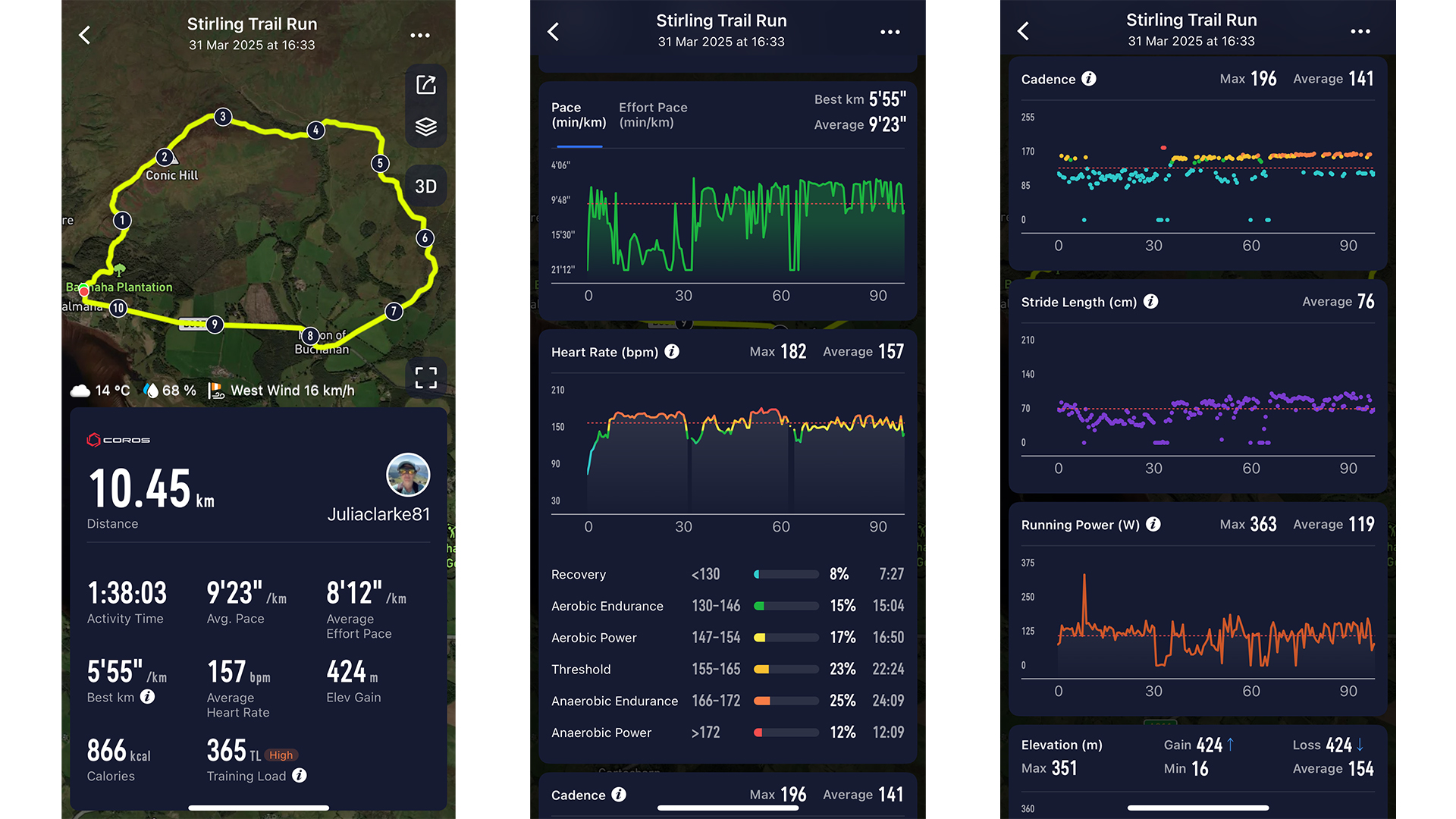
Value
It's not accurate to say that this is a budget GPS watch, but it's one of the more affordable watches with an AMOLED display that also offers topographical maps. If you're looking for a training watch with those features, this one is definitely more competitively priced than a lot of Garmins.
That said, between the plastic casing and mineral glass, the materials aren't as high quality as some other watches that have a similar or perhaps lower price tag. The durability isn't an issue for everyday adventures, but if you're planning a rugged, epic adventure, there could be a case for a slightly tougher watch.
Coros Pace Pro: the bottom line
For the most part, the Coros Pace Pro takes everything that's great about the Pace 3 and makes it better, but it's not without a few hitches. It's a straightforward, intuitive watch with some great perks like maps, an AMOLED screen and excellent training tools that set it on the same level as some far more expensive sports watches.
That said, it's not the highest quality build (but that in turn means it's cheaper and lighter) and its design means it's not ideal for all wrists. These are problems that won't arise for every user and one of which could be solved by introducing different sizes and choosing the right wrist strap.
Also consider
Less advanced and smaller than the Pace Pro, the Pace 3 offers the same interface and a lot of the same training tools but at a better price. The maps are simple pointer breadcrumb navigation on the Pace 3, but if you're not looking for a watch to help you navigate, that won't matter. It also doesn't have the AMOLED screen so it's harder to see in bright sunlight, but it's extremely accurate, has great battery life and comes at a nice price.
For
- Impressive battery life
- Straightforward to use
- Great metrics
- Lightweight and comfortable
- Stays put when you’re on the go
- Low profile design
- Waterproof
Against
- Lacks smartwatch features beyond message preview
- Looks a little cheap
- Screen can be a little hard to read on sunny days
If you don't mind a big watch, you won't mind the Suunto Vertical, which is made from similar materials to the Pace Pro and has excellent mapping, GPS and battery life. This watch is great for multi-day adventures and even though it was pricier than the Pace Pro when it was first released, you can now find it for a similar price.
For
- Excellent offline maps
- Great in-app route planner
- Super long battery life
- Extra large display
Against
- Some lag between menu screens
- Stainless steel version lacks solar charging







